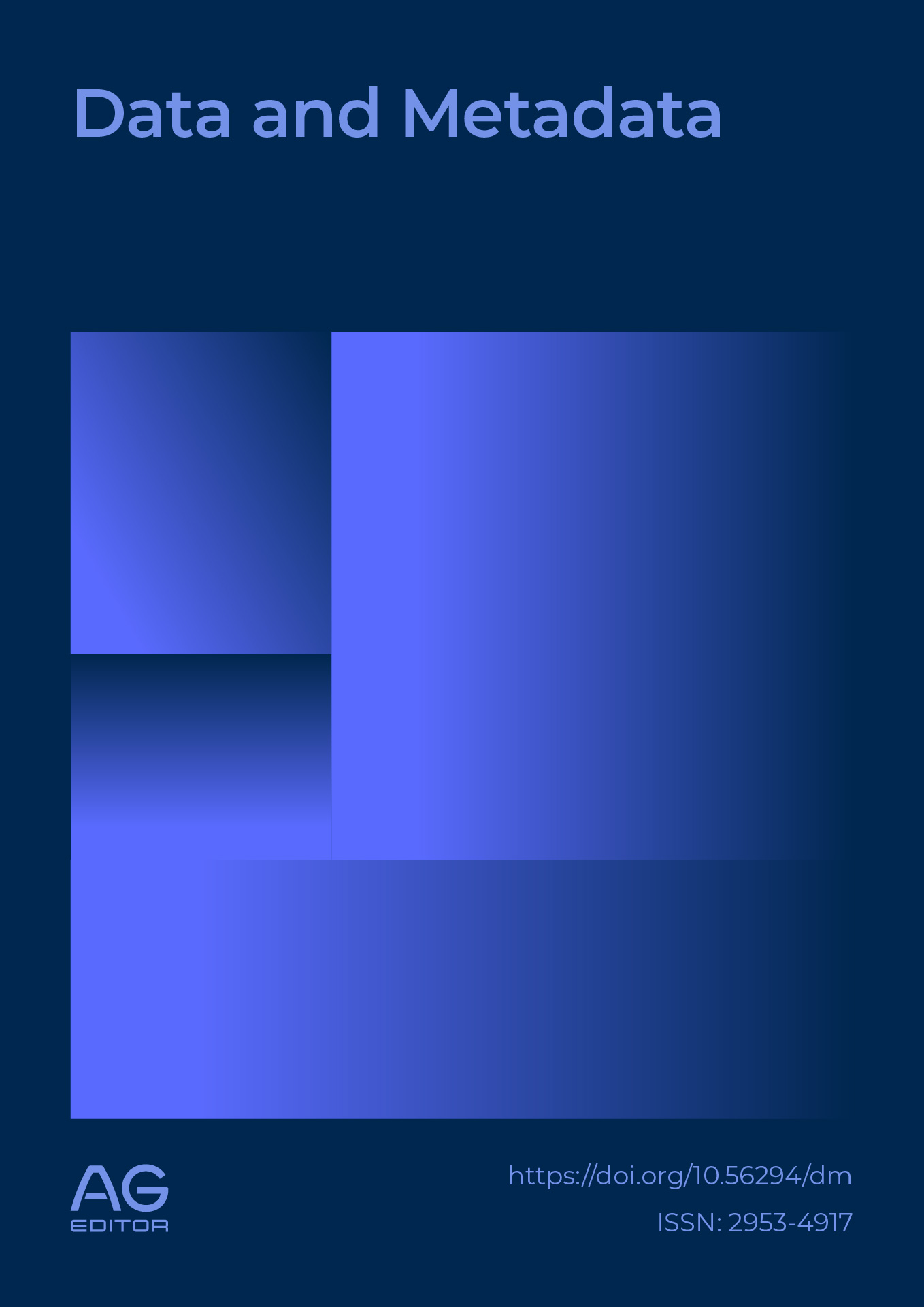Capital structure and debt tax shield: literature review and bibliometric analysis
DOI:
https://doi.org/10.56294/dm20251031Keywords:
Capital structure, Interest, Tax shields, Corporate taxesAbstract
Introduction: this study presents a bibliometric analysis and literature review focused on identifying publications, key themes, and recent trends in frontier research related to capital structure and the debt tax shield. The aim is to explore how the academic field has evolved over time and highlight the most influential works and recurring topics.
Methods: the study analyzed 33 documents indexed in Scopus, published between 1978 and 2023. A bibliometric approach was used to determine publication patterns, countries of origin, journal prominence, and citation metrics.
Results: the bibliometric analysis revealed that the United States accounts for the highest number of studies. Journals such as Applied Financial Economics and Investment Management and Financial Innovations lead in publication volume but not in citation count. The main themes explored by the authors include corporate debt policies, optimal capital structure, valuation of tax shields, trade-off and pecking order theories, corporate social responsibility, and profitability. Key research trends focus on evaluating factors such as debt levels, tax rates, credit risk, and future fiscal policies and their impact on the value of the tax shield. Additionally, recent works analyze the effects of events such as the COVID-19 crisis on leverage strategies and capital structure, as well as the integration of modern models—such as compensation and information asymmetry-based pecking order—with traditional theories.
Conclusions: The literature demonstrates a growing interest in understanding the interplay between tax factors and corporate financing decisions, especially in light of evolving economic contexts and theoretical frameworks. The field continues to expand through the incorporation of new models and empirical evidence, signaling opportunities for future research in this area.
References
1. Pinillos J, Gutiérrez M, Luna WB. Análisis financiero aplicado a una distribuidora de bienes y servicios del sector de automotores en la ciudad de Cúcuta, Norte de Santander. Gestión y Desarrollo Libre [Internet]. 2019 [citado 6 de mayo de 2025];4(7). Disponible en: https://revistas.unilibre.edu.co/index.php/gestion_libre/article/view/8130
2. Ortiz EJG, Duran JJ. Sostenibilidad empresarial en Colombia. Gestión y Desarrollo Libre [Internet]. 18 de septiembre de 2023 [citado 6 de mayo de 2025];8(16). Disponible en: https://revistas.unilibre.edu.co/index.php/gestion_libre/article/view/10494 DOI: https://doi.org/10.18041/2539-3669/gestionlibre.16.2023.10494
3. Kumar S, Colombage S, Rao P. Research on capital structure determinants: a review and future directions. IJMF. 3 de abril de 2017;13(2):106-32. DOI: https://doi.org/10.1108/IJMF-09-2014-0135
4. Sisodia A, Maheshwari GC. Capital Structure Study: A Systematic Review and Bibliometric Analysis. Vision: The Journal of Business Perspective. 13 de diciembre de 2022;097226292211304. DOI: https://doi.org/10.1177/09722629221130453
5. Haron R. Firm level, ownership concentration and industry level determinants of capital structure in an emerging market: Indonesia evidence. Vol. 14, Asian Academy of Management Journal of Accounting and Finance. 2018. p. 127-51. DOI: https://doi.org/10.21315/aamjaf2018.14.1.6
6. Valaskova K, Bakes V. Calculation of Tax Shields Using the Method of Adjusted Present Value. En: Tsounis N, Vlachvei A, editores. Advances in Panel Data Analysis in Applied Economic Research [Internet]. Cham: Springer International Publishing; 2018 [citado 10 de agosto de 2024]. p. 553-62. (Springer Proceedings in Business and Economics). Disponible en: http://link.springer.com/10.1007/978-3-319-70055-7_40 DOI: https://doi.org/10.1007/978-3-319-70055-7_40
7. Moher D, Liberati A, Tetzlaff J, Altman DG, for the PRISMA Group. Preferred reporting items for systematic reviews and meta-analyses: the PRISMA statement. BMJ. 21 de julio de 2009;339(jul21 1):b2535-b2535. DOI: https://doi.org/10.1136/bmj.b2535
8. Liberati A, Altman DG, Tetzlaff J, Mulrow C, Gotzsche PC, Ioannidis JPA, et al. The PRISMA statement for reporting systematic reviews and meta-analyses of studies that evaluate healthcare interventions: explanation and elaboration. BMJ. 4 de diciembre de 2009;339(jul21 1):b2700-b2700. DOI: https://doi.org/10.1136/bmj.b2700
9. Sarkis-Onofre R, Catalá-López F, Aromataris E, Lockwood C. How to properly use the PRISMA Statement. Systematic Reviews. 19 de abril de 2021;10(1):117. DOI: https://doi.org/10.1186/s13643-021-01671-z
10. Haron R, Nomran NM, Abdullah Othman AH, Md Husin M, Sharofiddin A. The influence of firm, industry and concentrated ownership on dynamic capital structure decision in emerging market. Vol. 15, Journal of Asia Business Studies. 2021. p. 689-709. DOI: https://doi.org/10.1108/JABS-04-2019-0109
11. Ritchken P, Wu Q. Capacity Investment, Production Flexibility, and Capital Structure. Vol. 30, Production and Operations Management. 2021. p. 4593-613. DOI: https://doi.org/10.1111/poms.13253
12. Chandra T, Chandra S, Wijaya E, Chandra J, Ng M. Co-determination of capital structure and profitability: An empirical test of Indonesia stock exchange. Vol. 19, Industrial Engineering and Management Systems. 2020. p. 561-75. DOI: https://doi.org/10.7232/iems.2020.19.3.561
13. Obay LA. The capital structure choice: Evidence of debt maturity substitution by GCC firms. Vol. 8, Asian Economic and Financial Review. 2018. p. 1298-312. DOI: https://doi.org/10.18488/journal.aefr.2018.811.1298.1312
14. Saif-Alyousfi AYH, Md-Rus R, Taufil-Mohd KN, Mohd Taib H, Shahar HK. Determinants of capital structure: evidence from Malaysian firms. Vol. 12, Asia-Pacific Journal of Business Administration. 2020. p. 283-326. DOI: https://doi.org/10.1108/APJBA-09-2019-0202
15. Modigliani F, Miller MH. The Cost of Capital, Corporation Finance and the Theory of Investment. The American Economic Review. 1958;48(3):261-97.
16. Modigliani F, Miller MH. Corporate Income Taxes and the Cost of Capital: A Correction. The American Economic Review. 1963;53(3):433-43.
17. Kraus A, Litzenberger RH. A State-Preference Model of Optimal Financial Leverage. The Journal of Finance. 1973;28(4):911-22. DOI: https://doi.org/10.1111/j.1540-6261.1973.tb01415.x
18. Stiglitz JE. Taxation, corporate financial policy, and the cost of capital. Journal of Public Economics. febrero de 1973;2(1):1-34. DOI: https://doi.org/10.1016/0047-2727(73)90008-X
19. Jensen MC, Meckling WH. Theory of the firm: Managerial behavior, agency costs and ownership structure. Journal of Financial Economics. 1 de octubre de 1976;3(4):305-60. DOI: https://doi.org/10.1016/0304-405X(76)90026-X
20. Miller MH. DEBT AND TAXES*. The Journal of Finance. mayo de 1977;32(2):261-75. DOI: https://doi.org/10.1111/j.1540-6261.1977.tb03267.x
21. Ross SA. The Determination of Financial Structure: The Incentive-Signalling Approach. The Bell Journal of Economics. 1977;8(1):23-40. DOI: https://doi.org/10.2307/3003485
22. Bradley M, Jarrell GA, Kim EH. On the Existence of an Optimal Capital Structure: Theory and Evidence. The Journal of Finance. 1984;39(3):857-78. DOI: https://doi.org/10.1111/j.1540-6261.1984.tb03680.x
23. Kane A, Marcus AJ, McDonald RL. How Big is the Tax Advantage to Debt? The Journal of Finance. julio de 1984;39(3):841. DOI: https://doi.org/10.2307/2327948
24. Myers SC, Majluf NS. Corporate financing and investment decisions when firms have information that investors do not have. Journal of Financial Economics. junio de 1984;13(2):187-221. DOI: https://doi.org/10.1016/0304-405X(84)90023-0
25. Fischer EO, Heinkel R, Zechner J. Dynamic Capital Structure Choice: Theory and Tests. The Journal of Finance. marzo de 1989;44(1):19-40. DOI: https://doi.org/10.1111/j.1540-6261.1989.tb02402.x
26. Harris M, Raviv A. The Theory of Capital Structure. The Journal of Finance. marzo de 1991;46(1):297-355. DOI: https://doi.org/10.1111/j.1540-6261.1991.tb03753.x
27. Baker M, Wurgler J. Market Timing and Capital Structure. The Journal of Finance. febrero de 2002;57(1):1-32. DOI: https://doi.org/10.1111/1540-6261.00414
28. Učkar D. Behavioral elements in capital structure management. En 2012 [citado 27 de agosto de 2024]. p. 168-76. Disponible en: https://www.croris.hr/crosbi/publikacija/prilog-skup/640550
29. Caraballo LJ, Eslava-Zapata R, Calderón-Ortega M. Evaluation of the Production Function of Health in the Countries of the Organization for Economic Cooperation and Development, Latin America and Colombia. Seminars in Medical Writing and Education. 27 de abril de 2025;4:460-460. DOI: https://doi.org/10.56294/mw2025460
30. Nga NTV, Long GN. The choice of capital structure: A study on energy industry in a developing country. Vol. 7, Accounting. 2021. p. 289-94. DOI: https://doi.org/10.5267/j.ac.2020.12.002
31. Heckenbergerová J, Honková I. Capital structure analysis – theories and determinants validation based on evidence from the czech republic. Vol. 26, E a M: Ekonomie a Management. 2023. p. 145-64. DOI: https://doi.org/10.15240/tul/001/2023-1-009
32. Naser K, Al-Mutairi A, Al Kandari A, Nuseibeh R. Cogency of capital structure theories to an Islamic country: Empirical evidence from the Kuwaiti banks. Vol. 5, International Journal of Economics and Financial Issues. 2015. p. 979-88.
33. Liang J, Li LF, Song HS. An explanation of capital structure of China’s listed property firms. Vol. 32, Property Management. 2014. p. 4-15. DOI: https://doi.org/10.1108/PM-02-2013-0012
34. Michaelas N, Chittenden F, Poutziouris P. Policy implications arising from the impact of the last recession on the capital structure of UK SMEs. Vol. 17, Environment and Planning C: Government and Policy. 1999. p. 411-30. DOI: https://doi.org/10.1068/c170411
35. Jou JB, Lee T. Optimal Capital Structure in Real Estate Investment: A Real Options Approach [Internet]. Vol. 14, International Real Estate Review. 2011. Disponible en: https://www.scopus.com/inward/record.uri?eid=2-s2.0-85065906359&partnerID=40&md5=7273a468c09c68eb5adb6864ea24b384
36. DeAngelo H, Masulis RW. Optimal capital structure under corporate and personal taxation. Vol. 8, Journal of Financial Economics. 1980. p. 3-29. DOI: https://doi.org/10.1016/0304-405X(80)90019-7
37. Gabrielli A. The Debt and Non-Debt Tax Shields Trade-Off: A Review. IJARAFMS. 19 de enero de 2023;13(1):Pages 88-103. DOI: https://doi.org/10.6007/IJARAFMS/v13-i1/16170
38. Sheikh NA, Qureshi MA. Crowding-out or shying-away: Impact of corporate income tax on capital structure choice of firms in Pakistan. Vol. 24, Applied Financial Economics. 2014. p. 1249-60. DOI: https://doi.org/10.1080/09603107.2014.925053
39. Hull RM. A capital structure model. Vol. 4, Investment Management and Financial Innovations. 2007. p. 8-24.
40. Schnabel JA. Bankruptcy, interest tax shields and ‘optimal’ capital structure: A cash flow formulation. Vol. 5, Managerial and Decision Economics. 1984. p. 116-9. DOI: https://doi.org/10.1002/mde.4090050210
41. Mendell BC, Sydor T, Mishra N. Capital structure in the United States forest products industry: The influence of debt and taxes. Vol. 52, Forest Science. 2006. p. 540-8. DOI: https://doi.org/10.1093/forestscience/52.5.540
42. Dong Z. Capital structure decisions of LPTs in a small economy. Vol. 30, Journal of Property Investment and Finance. 2012. p. 493-504. DOI: https://doi.org/10.1108/14635781211256756
43. Zhang Z. Determining the optimal capital structure based on revised definitions of tax shield and bankruptcy cost. Vol. 3, Frontiers of Business Research in China. 2009. p. 120-44. DOI: https://doi.org/10.1007/s11782-009-0007-1
44. Bogovac J. Theoretical models of capital structure of companies and their tax law aspects; [Teorijski modeli financijske strukture trgovačkih društava i njihovi poreznopravni aspekti]. Vol. 61, Zbornik Pravnog Fakulteta u Zagrebu. 2011. p. 1561-600.
45. Singh K, Hodder JE. Multinational capital structure and financial flexibility. Vol. 19, Journal of International Money and Finance. 2000. p. 853-84. DOI: https://doi.org/10.1016/S0261-5606(00)00038-3
46. Buus T. A general free cash flow theory of capital structure. Vol. 16, Journal of Business Economics and Management. 2015. p. 675-95. DOI: https://doi.org/10.3846/16111699.2013.770787
47. Ni Y, Guo S, Giles DE. Capital structures in an emerging market: A duration analysis of the time interval between IPO and SEO in China. Vol. 20, Applied Financial Economics. 2010. p. 1531-45. DOI: https://doi.org/10.1080/09603107.2010.505552
48. Mundi HS, Kaur P. CEO Overconfidence and Capital Structure Decisions: Evidence from India. Vol. 47, Vikalpa. 2022. p. 19-37. DOI: https://doi.org/10.1177/02560909221079270
49. Herrera RA, Gómez AAH, Peñate MU, García ÁRS, Alvear NVC. Profitability and capital structure in Ecuadorian tourism companies: A PLS-SEM approach; [Rentabilidad y estructura de capital en empresas ecuatorianas de turismo: Un enfoque PLS-SEM]. Vol. 2023, RISTI - Revista Iberica de Sistemas e Tecnologias de Informacao. 2023. p. 370-83.
50. Correa García JA, Castaño Ríos CE, Mesa Callejas RJ. Desempeño financiero empresarial en Colombia en 2009: un análisis por sectores. Perfil de Coyuntura Económica. agosto de 2010;(15):149-70.
51. Matemilola BT, Bany-Ariffin AN, Azman-Saini WNW, Nassir AM. Does top managers’ experience affect firms’ capital structure? Vol. 45, Research in International Business and Finance. 2018. p. 488-98. DOI: https://doi.org/10.1016/j.ribaf.2017.07.184
52. Guizani M, Ajmi AN. Testing the pecking order theory of capital structure in an Islamic legal system: the case of Saudi Arabia. Vol. 14, International Journal of Islamic and Middle Eastern Finance and Management. 2021. p. 732-52. DOI: https://doi.org/10.1108/IMEFM-05-2019-0216
53. Liu WC. Trade-off theory of capital structure: Evidence from estimations of non-parametric and semi-parametric panel fixed effect models. Vol. 14, Investment Management and Financial Innovations. 2017. p. 115-23. DOI: https://doi.org/10.21511/imfi.14(1).2017.12
54. Caraballo LJ, Zapata RE, Castillo VS. Comercio agroalimentario entre Colombia y Venezuela: un estudio basado en el modelo de corrección de errores. Agroalimentaria. 20 de marzo de 2025;31(60):35-64. DOI: https://doi.org/10.53766/Agroalim/2025.31.60.03
Published
Issue
Section
License
Copyright (c) 2025 Jesús Alexander Pinillos Villamizar, Hugo Macias, Luis Castrillon (Author)

This work is licensed under a Creative Commons Attribution 4.0 International License.
The article is distributed under the Creative Commons Attribution 4.0 License. Unless otherwise stated, associated published material is distributed under the same licence.




